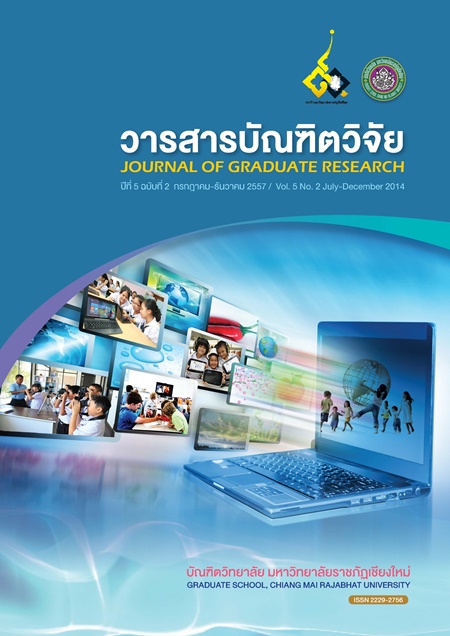รูปแบบการพัฒนาสมรรถนะบุคลากรของมหาวิทยาลัยราชภัฏเชียงใหม่
Main Article Content
Abstract
การวิจัยครั้งนี้มีวัตถุประสงค์เพื่อเพื่อศึกษาสมรรถนะบุคลากรที่เป็นอยู่ในปัจจุบันกับสมรรถนะที่จำเป็นต้องมีของมหาวิทยาลัยราชภัฏเชียงใหม่และวิเคราะห์รูปแบบการพัฒนาสมรรถนะบุคลากรของมหาวิทยาลัยราชภัฏเชียงใหม่ตัวอย่างที่ใช้ในการศึกษาวิจัยครั้งนี้ คือ บุคลากรของมหาวิทยาลัยราชภัฏเชียงใหม่ แบ่งเป็น ผู้บริหาร จำนวน 47 คน สายวิชาการ จำนวน 131 คน สายและสนับสนุน จำนวน 131 คน รวมจำนวนทั้งสิ้น 309 คน การวิจัยครั้งนี้เป็นการวิจัยเชิงสำรวจ โดยใช้แบบสอบถามเป็นเครื่องมือในการวิจัยและใช้โปรแกรมสำเร็จรูปทางสถิติ (SPSS) ในการวิเคราะห์ข้อมูลใช้สถิติ ร้อยละ ค่าเฉลี่ย และค่าเบี่ยงเบนมาตรฐาน
ผลการวิจัยพบว่า จากการแบ่งระดับสมรรถนะหลัก และสมรรถนะประจำกลุ่มงาน บุคลากรของมหาวิทยาลัยราชภัฏเชียงใหม่ที่จำเป็นต้องมีและที่เป็นอยู่ในปัจจุบัน ออกเป็น 1-5 ระดับคะแนน คือ คะแนน 1 คะแนน หมายถึง มีสมรรถนะน้อยที่สุด ระดับ 2 หมายถึง มีสมรรถนะในระดับน้อย ระดับ 3 หมายถึง มีสมรรถนะในระดับปานกลาง ระดับ 4 หมายถึง มีสมรรถนะในระดับมาก ระดับ 5 หมายถึง มีสมรรถนะในระดับมากที่สุด และการการแปรความหมายของคะแนน การวิเคราะห์ช่องว่าง (Gap Analysis) ออกเป็นช่วงคะแนน 1–5 คะแนน คือ ค่าเฉลี่ย 4.21–5.00 ระดับสมรรถนะที่ต้องได้รับการพัฒนามากที่สุด ค่าเฉลี่ย 3.41–4.20 ระดับสมรรถนะที่ต้องได้รับการพัฒนามาก ค่าเฉลี่ย 2.61 -3.40 ระดับสมรรถนะที่ต้องได้รับการพัฒนาปานกลาง ค่าเฉลี่ย 1.81-2.60 ระดับสมรรถนะที่ต้องได้รับการพัฒนาน้อย ค่าเฉลี่ย 1.00–1.80 ระดับสมรรถนะที่ต้องได้รับการพัฒนาน้อยที่สุด
MODEL FOR DEVELOPING PERSONAL’S COMPETENCIES OF CHIANG MAI RAJABHAT UNIVERSITY.
The objectives of this study were to explore existing and necessary personnel competency of Chiangmai Rajabhat University and to analyze a model of personnel competency development of Chiangmai Rajabhat University. The sample was 309 personnel in Chiangmai Rajabhat University, consisted of 47 administrators, 131 academic staffs, and 131 support staffs. This study was survey research. The research instrument was questionnaire. Data was analyzed by SPSS, percentage, mean, and standard deviation.
For necessary competency, overallcore competency of ChiangmaiRajabhat university’s administrators, academic staffs, and supporting staffs was at highest level. Administrators had functional competency at high level; academic staffs at highest level and supporting staffs at high level. In terms of existing competency, administrators hadcore competency at high level, academic staffs at moderate level, and supporting staffs at moderate level. For existing competency, overallfunctional competency of administrators, academic staffs, and supporting staffs was at moderate level. A model of personnel competency development of Chiangmai Rajabhat University was analyzed by comparing necessary competency with existing competency. The analytic results showed that overall the requirement of developing competency among administrators, academic staffs, and supporting staffswas at lowest level. However, practically, the personnel development to meet higher level of competency is important. Systematic and ominous personnel development should be further performed.


